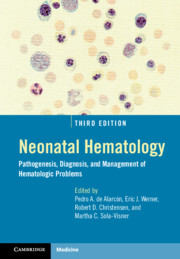Book contents
- Neonatal Hematology
- Neonatal Hematology
- Copyright page
- Contents
- Foreword
- Preface
- Contributors
- Section I Developmental Hematology
- Section II Bone Marrow Failure and Immune Disorders
- Section III Erythrocyte Disorders
- Section IV Platelet Disorders
- Section V Leucocyte Disorders
- Section VI Hemostatic Disorders
- Chapter 18 Bleeding Disorders
- Chapter 19 Neonatal Thrombosis
- Section VII Neonatal Transfusion Medicine
- Section VIII Neonatal Oncology
- Section IX Miscellaneous
- Index
- Plate Section (PDF Only)
- References
Chapter 19 - Neonatal Thrombosis
from Section VI - Hemostatic Disorders
Published online by Cambridge University Press: 30 January 2021
- Neonatal Hematology
- Neonatal Hematology
- Copyright page
- Contents
- Foreword
- Preface
- Contributors
- Section I Developmental Hematology
- Section II Bone Marrow Failure and Immune Disorders
- Section III Erythrocyte Disorders
- Section IV Platelet Disorders
- Section V Leucocyte Disorders
- Section VI Hemostatic Disorders
- Chapter 18 Bleeding Disorders
- Chapter 19 Neonatal Thrombosis
- Section VII Neonatal Transfusion Medicine
- Section VIII Neonatal Oncology
- Section IX Miscellaneous
- Index
- Plate Section (PDF Only)
- References
Summary
Thromboembolism (TE) in pediatrics is relatively rare compared with adults, with an estimated venous thromboembolism (VTE) incidence of 0.07–0.14/10,000 children [1, 2]. A bimodal age distribution has been well demonstrated in the pediatric VTE population and children less than 1 year of age, especially those less than 1 month of age, are most commonly affected [1, 2]. The incidence of VTE in this very young population, particularly when hospitalized, is increasing [3–6]. Between 1997 and 2018, up to a 13-fold increase in neonatal TE incidence has been described in all live births and a greater than six-fold increase in neonatal TE incidence has been described for neonatal intensive care unit (NICU) admissions [4–7]. This increase has been attributed to improving survival rates in critically ill and/or premature neonates, the increased utilization of central venous catheters (CVC), and a much greater awareness of VTE and the associated risk factors in this population [3, 6, 8, 9]. The aim of this chapter is to review the congenital and acquired risk factors associated with neonatal TE and to discuss the clinical presentation, diagnosis, and management of this rare complication that has been shown to significantly impact the morbidity and mortality rates of those afflicted [1–3, 8].
- Type
- Chapter
- Information
- Neonatal HematologyPathogenesis, Diagnosis, and Management of Hematologic Problems, pp. 312 - 328Publisher: Cambridge University PressPrint publication year: 2021



